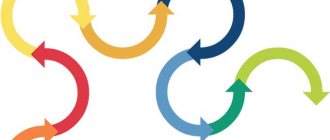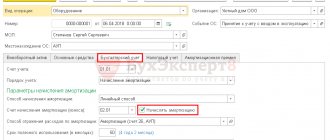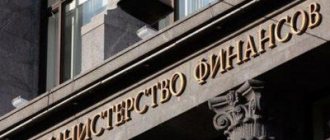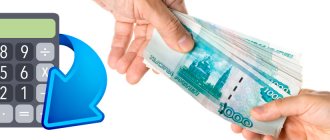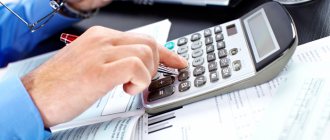Accounting for depreciation in the conduct of economic activities of any company is very important and every accountant needs to know what depreciation deductions, depreciation expenses are and successfully apply this in practice. As everyone knows, sooner or later, any thing ceases to be “new” and succumbs to wear and tear, while losing value. The same thing happens with fixed assets (FPE) of the company - provided that they do not change their material form, characteristics, fixed assets transfer part of their value to the newly created product, while becoming its cost. In this article, let's look at what depreciation is, what types exist, and how it is accounted for.
Depreciation is a loss inherent in any business.
What is depreciation
Let's figure out what depreciation is, how to calculate it and use it to optimize your business. The term “depreciation” itself (translated from the Latin “amortisatio”) means nothing more than “repayment”. Regulatory documents of the state regulator - the Ministry of Finance of the Russian Federation indicate that the cost of fixed assets is repaid through depreciation. In other words, depreciation is a gradual transfer of the cost of fixed assets to the cost price (work, services, products). Previously, this type of accounting was applicable only to commercial organizations, but now depreciation for non-profit companies is calculated in the general manner.
Depreciation of fixed assets is, at a minimum, order in the reporting, and at a maximum – minimal losses and economically profitable operation of the business. The types of depreciation are different for accounting (AC) and tax accounting (TA), which we will discuss further.
What objects are depreciation calculated for?
Before we understand how depreciation is calculated, let’s understand the objects to which it applies.
Property and results of intellectual activity that the company owns by right of ownership, economic management or operational management and uses for profit-making purposes are depreciated. In accordance with Art. 256 of the Tax Code of the Russian Federation, the useful life of such property must exceed 12 months, and the initial cost is 100,000 rubles.
The company's fixed assets have a number of characteristics:
- Firstly, they are repeatedly involved in the production process;
- Secondly, they are characterized by the transfer of value to finished products gradually, as they wear out;
- Thirdly, the absence of changes in its natural material form.
Objects of depreciation are clearly established in the legislation of the Russian Federation.
Types of fixed assets are distinguished:
- By composition;
- According to natural and material characteristics;
- By role in the product creation process.
Also, the composition of fixed assets of an organization determines movable and immovable parts. Depending on the specific role in the process of creating products, active and passive operating systems are distinguished.
Depreciation of fixed assets is a process that takes into account property owned, from the use of which profit is made, with a service life of more than 12 months and a cost of more than 40 thousand rubles.
Depreciation of fixed assets
Savicheva Olga
Corporate accountant, practicing economist
Ask a Question
Depreciation of fixed assets does not occur when the property remains unchanged over time. Moreover, we are talking not only about condition, but also about cost. A change in value is possible, but this will in no way be related to depreciation. The legislation includes land plots, subsoil, water resources, other environmental management facilities, raw materials, manufactured goods, unfinished construction projects, securities and more. Also, it is important to know that, being property on the company’s balance sheet, property acquired using budget funds for targeted financing, property of non-profit organizations, as well as external improvement objects are not depreciated.
OS classification
The useful life of an object of depreciable property is determined by the taxpayer independently on the date of putting the fixed asset into operation in accordance with the provisions of the Tax Code of the Russian Federation and taking into account the Classification of fixed assets.
OS classifications are a table in which for each group the name of the OS included in it and the corresponding code of the All-Russian Classifier of Fixed Assets (OKOF) are indicated.
Currently, the Classification is a table consisting of three columns, the first of which indicates the OKOF code, the second column - the name of the OS, and the third column contains “Notes on OS names” (where exceptions or additional explanations may be indicated) .
Within the depreciation groups, fixed assets are grouped into subgroups - Machinery and equipment, Transport vehicles, Structures and transmission devices, Buildings, Dwellings, Perennial plantings, Working livestock.
Let us note that tax legislation does not establish for the purposes of calculating depreciation the unconditional application of the maximum useful life.
Thus, according to the rules of paragraph 3 of Article 258 of the Tax Code of the Russian Federation, the taxpayer classifies fixed assets into one of ten depreciation groups.
At the same time, the OS Classification provides for the useful life of objects in the range of minimum and maximum values.
Thus, the Tax Code of the Russian Federation does not oblige the company to establish exactly the maximum permissible useful life of an asset.
Useful life
There is also more than one way to calculate the useful life:
- calculate how long the use is profitable. Although there is no requirement in the law, we recommend setting it in months;
- count as the quantity of products or volume of work (in physical terms) that you plan to receive. We recommend setting it in pieces, square meters, etc.
To determine the useful life, it is necessary to take into account the expected period of operation, the level of physical wear and tear, as well as plans for the replacement (technical re-equipment) of fixed assets.
It is important to remember that during conservation, reconstruction, modernization, depreciation is suspended.
The useful life for the purposes of further calculation of depreciation can be determined by two types of calculations: through dividing fixed assets into types, or calculated for each type separately.
Further, the obtained indicators of all types of means of production are combined into a single number and already in this form are used to calculate the depreciation of equipment.
Technological progress and the linear method
The advantage of straight-line write-off of depreciation, which underlies the straight-line method, completely disappears if the company's assets are subject to rapid obsolescence.
These could be cars, machine tools, exclusive rights to computer programs and other non-financial assets, the use of which becomes ineffective due to the emergence of new, more advanced models and designs.
Real estate can also become obsolete if it no longer meets modern requirements for ergonomics, quality and volume of services provided.
If technological progress and changing requirements influence the rapid obsolescence of an asset, the feasibility of using non-linear methods should be considered when choosing a depreciation model.
In this case, straight-line depreciation does not provide a sufficient concentration of resources necessary to replace the asset. For those companies that plan to quickly update production assets, it is more profitable to use non-linear methods of calculating depreciation.
Methods for calculating depreciation
There are several types of depreciation. For accounting and tax accounting they are different. The method is selected depending on the characteristics of the object, initial cost, service life, acceleration factors and other conditions. Let's consider the features of each method of calculating deductions separately.
Linear method
The most common calculation method is linear. According to statistics, it is practiced by about 3/4 of businesses in Russia. Also, in practice, it is the simplest. The linear method applies to objects such as structures, buildings, transmission devices and intangible assets.
The essence of the linear method of calculating depreciation is to remove depreciation funds in equal parts over the entire useful life. The calculation begins with the initial cost of the fixed assets from the reporting documents - the amount spent on the acquisition of the asset.
Formula for calculating the amount to be written off
The deduction rate is a percentage of the original cost of the asset. It is determined by the formula:
Formula for calculating the deduction rate
Nonlinear methods, in turn, allow accounting departments to write off depreciation unevenly. In practice, it is sometimes more profitable to remove the main costs of acquiring fixed assets in the first years of their use. Non-linear methods are not applicable to assets individually, but are used to calculate the depreciation of funds from one depreciation group.
There are four types of calculating depreciation in a non-linear way:
- reducing balance method;
- method of write-off based on the sum of years of useful life;
- a method of reducing cost in proportion to the volume of work;
- accelerated method.
Next we will consider each type separately.
Reducing balance method
The key indicator for this method is the acceleration coefficient. It is established by law, but with restrictions. In accordance with Art. 259 of the Tax Code of the Russian Federation, the reducing balance method does not allow reducing the residual value to 0, and the remainder of 20% of the initial cost of the asset is a fixed value. Then, each month, the cost of the fixed asset group is reduced by an amount that is calculated by dividing the remaining amount by the number of months remaining until the end of its useful life.
It is important to establish the residual value of the object at the beginning of the year and calculate the depreciation rate taking into account the acceleration coefficient, using the formula:
Calculation formula taking into account the acceleration coefficient
Method of writing off cost based on the sum of the numbers of years of useful life
The key indicator for calculation is the time period of use.
To account for this method, you need to calculate the annual ratio of the remaining service life of the object (T rest.) to the entire useful life, using the following formula:
Σ depreciation = Σ original cost x (Tost. / T useful use (T useful use + 1) / 2)
The method of writing off the cost in proportion to the volume of products (works)
The volume of products produced (work performed) for a specified period (V prod.) and the initial cost of the corresponding fixed asset are taken into account. Calculation formula:
Σ depreciation = Σ initial cost / V cont.
It is worth choosing this accounting method when depreciation largely depends on the frequency of use of the fixed asset.
There are several effective ways to calculate depreciation charges
Accounting for fixed assets: depreciation using the reducing balance method
This method is relevant for assets operated with varying degrees of intensity, the peak of which occurs in the first years after commissioning. For example, office equipment, CNC equipment, software products and many intellectual objects tend to become obsolete after several years from the date of commissioning.
This method is a calculation of fixed assets depreciation based on the residual value of the asset, determined at the beginning of each year, and can be used to calculate depreciation for any groups of similar objects. This value is calculated by multiplying the residual value at the beginning of the year, the depreciation rate and the coefficient established by the company that accelerates the write-off of the asset value.
Companies are allowed to use an accelerating index in calculating depreciation, limiting its value to 3 (clause 19 of PBU 6/01). Its use must be technically and economically justified, i.e. the right to accelerated depreciation must be documented.
Example
In April 2021, the company purchased and put into operation a computer-controlled machine worth 900,000 rubles. and SPI 3 years. Technical documentation justifies the use of an acceleration factor of 2.5%. Accrual of depreciation began in May 2021. To calculate the monthly amount of depreciation, the annual depreciation rate is calculated taking into account the increasing index:
100% / 3 years x 2.5% = 83.33%;
Calculation of depreciation for each year of operation of the OS:
| Calculation period | Residual value at the beginning of the year | Depreciation | |
| per month | in a year | ||
| 01.05 – 31.12.2018 | 900 000,00 | 900,000 x 83.33% /12 months. = 62,497.50 | 62,497.5 x 8 months = 499,980 |
| 01.01 – 31.12.2019 | 900 000 – 499 980 = 400 020 | 400,020 x 83.33% /12 = 27,778.06 | 400,020 x 83.33% = 333,336.67 |
| 01.01 – 31.12.2020 | 400 020 – 333 336,67 = 66 683,33 | 66,683.33 x 83.33% / 12 = 4630.6 | 66,683.33x 0.8333= 55,567.22 |
| 01.01 – 30.04.2021 | 66 683,33 – 55 567,22 = 11 116,11 | 11,116.11 x 83.33% / 12 = 771.92 | 771.92 x 4 months. = 3087.68 |
| Total as of 05/01/2021 | 891 971,57 | ||
It is impossible to calculate depreciation using this method with full reimbursement of the cost of the asset as of the end date of the SPI. The residual value of the machine as of 04/30/2021 in the example was 8028.43 rubles. (900,000 – 891,971.57). The company has the right to include the remaining amount in the amount of accrued depreciation in April 2021, or from the beginning of 2021 switch to the straight-line method of calculating depreciation, accruing depreciation monthly at 771.92 rubles. until full reimbursement of the cost, or distribute the residual value of the object as of 01/01/2021 over the last 4 months of 2779.03 rubles. (11,116.11 / 4) and write it off evenly.
The accounting entries will be as follows:
| Operations | D/t | K/t | Sum |
| OS launch in April 2018 | 01 | 08 | 900 000 |
| Depreciation is calculated monthly: | |||
| — from May to December 2018 | 20 | 02 | 62 497,50 |
| — in 2019 | 20 | 02 | 27 778,06 |
| — in 2020 | 20 | 02 | 4630,60 |
| — from January to April 2021 | 20 | 02 | 771,92 |
| Let us assume that the accounting policy of the enterprise stipulates a one-time write-off of the cost of the object in the last month of depreciation. Then in April 2021 the wiring will be completed | 20 | 02 | 8028,43 |
Which depreciation method to choose?
In order for an accountant to choose a method for calculating and accounting for depreciation, it is necessary to understand, first of all, the relationship between time and the expected economic benefits from using an asset or group of assets.
Of course, it is necessary to be able to apply all types of depreciation in practice, since the property of organizations is always heterogeneous.
Currently, the law directly establishes general requirements for the method of depreciation of fixed assets chosen by the organization. The chosen method should most accurately reflect the distribution over time of the expected future economic benefits from the use of a group of fixed assets; be applied consistently from one reporting period to the next; the amount of depreciation of an item of fixed assets for the reporting period should be determined in such a way that by the end of the period the book value of the selected item becomes equal to its liquidation value.
Procedure if the OS object is not in the classification
Not all types of fixed assets can be found in the OS Classification.
In this case, you should look at the OS code in OKOF and determine the depreciation group according to this code.
If the object is not indicated in the OKOF, then to establish its useful life, you should use its technical documentation or the recommendations of the manufacturers (clause 6 of Article 258 of the Tax Code of the Russian Federation).
In the absence of such information, to resolve the issue of determining the useful life of a fixed asset, you should contact the Ministry of Economic Development of Russia.
How to calculate the annual depreciation rate
Every year, the accounting department needs to report on depreciation expenses. They are expressed as percentages or shares of the cost of the OS.
The formula for calculation using the linear method, according to clause 19 of PBU 6/01, is as follows:
Here is the calculation formula using the linear method
With the method of writing off value based on the sum of the numbers of years of the useful life, the calculation does not involve the use of a depreciation rate at all. At least, such an indicator is not mentioned in the description of the procedure for calculating the amount of depreciation. However, understanding the depreciation rate as the share of the cost of an asset subject to recognition in the current year, for the annual depreciation rate the formula for this method can be presented as follows:
N = CL / ∑ CL
where KL is the number of years remaining until the end of the SPI of the asset;
∑ CL – the sum of years of SPI of the OS object.
Shock absorption groups
Shock absorption groups
– these are groups into which depreciable property is divided in accordance with its useful life on the basis of regulations.
The concept of “depreciation group” is used primarily for income tax purposes, and is also used for accounting purposes.
The main point of assigning a specific object to a particular depreciation group is to determine its useful life in order to establish the depreciation rate, and to calculate the amount of depreciation.
In tax accounting, for calculating depreciation depending on the useful life (SPI), fixed assets are distributed into ten depreciation groups in ascending order.
The first depreciation group is all short-lived property with a useful life from 1 year to 2 years inclusive;
The second depreciation group is property with a useful life of more than 2 years up to 3 years inclusive;
The third depreciation group is property with a useful life of more than 3 years up to 5 years inclusive;
The fourth depreciation group is property with a useful life of more than 5 years up to 7 years inclusive;
The fifth depreciation group is property with a useful life of over 7 years up to 10 years inclusive;
The sixth depreciation group is property with a useful life of over 10 years up to 15 years inclusive;
The seventh depreciation group is property with a useful life of over 15 years up to 20 years inclusive;
The eighth depreciation group is property with a useful life of over 20 years up to 25 years inclusive;
The ninth depreciation group is property with a useful life of over 25 years up to 30 years inclusive;
The tenth depreciation group is property with a useful life of over 30 years.
The useful life of a fixed asset is the period (number of months) during which the company expects to use the fixed asset and receive economic benefits from it.
Depreciation of used fixed assets
In its letter (No. 03-03-06/1/2355 dated January 20, 2020), the Ministry of Finance answers the question about depreciation of used assets. The initial cost is calculated in the usual manner.
However, the useful life of such an asset will be shorter and determined on the date of commissioning of the facility. To make calculations, the accountant is guided by 20 PBU 6/01 “Accounting for fixed assets.”
Thus, the new owner determines the depreciation rate for purchased used assets, taking into account the SPI that was established by the previous owner.
Accounting for depreciation of fixed assets using the cost write-off method based on the sum of the number of years of SPI
For assets with the maximum degree of return in the first years of operation, this method is also suitable - based on the sum of the number of years of useful life. Depreciation is calculated by multiplying the original cost of the asset and the ratio of the number of years remaining until the end of its service life to the sum of the number of years of SPI.
For example, for an OS object with an initial cost of 200,000 rubles. and three-year SPI depreciation will be calculated as follows:
| Period | Depreciation per year | Residual value at the end of the year |
| 1 year | 200,000 x 3 / (1+2+3) = 100,000 | 100 000 (200 000 – 100 000) |
| 2 year | 200,000 x 2 / (1+2+3) = 66,666.67 | 33 333,33(100 000 – 66 666,67) |
| 3 year | 200,000 x 1/ (1+2+3) = 33,333.33 | 0 (33 333,33 – 33 333,33) |
Accrual of depreciation of fixed assets in accounting will be recorded using the same posting - D/t 20 K/t 02.
What is accumulated depreciation
Accumulated depreciation and residual value are closely related:
OS = NS - NA, which means NA = NS - OS
The residual value, which is determined by this formula, is also called the historical cost of fixed assets.
Accumulated depreciation
Savicheva Olga
Corporate accountant, practicing economist
Ask a Question
At the end of each month, the company revaluates fixed assets and determines their residual value to determine liquidation or replacement value. The accumulation of accumulated depreciation on any property is also recorded every month in the reporting documentation of the organization, and the calculation procedure depends on the type of object, features of use and depreciation method.
Accounting for accrued depreciation
After depreciation has been calculated, it is necessary to summarize it and further record it in accounting documents. For these purposes, passive account 02 “Depreciation of fixed assets” is used.
The amount of accrued depreciation is reflected taking into account the transactions, namely:
Debit 20 (23, 25, 44) – Credit 02 – reflects depreciation on fixed assets that are used in the production of products, when performing work and providing services.
For example, if an organization whose activities are not related to construction makes capital investments using fixed assets, then it must reflect the following in its accounting:
Debit 08.3 – Credit 02 – reflects depreciation on fixed assets that are involved in capital work.
Application of the OS Classification in accounting
Let us note that the rule that the specified Classification of fixed assets can be used for accounting purposes from 01/01/2017 was declared invalid.
Therefore, in accounting, when establishing useful lives, the rules established by regulatory acts on accounting should be applied.
So, if an organization independently sets the useful life of fixed assets, guided by the provisions of paragraph 20 of PBU 6/01, then in this case the useful life of fixed assets is determined based on:
the expected life of the facility in accordance with its expected productivity or capacity;
expected physical wear and tear, depending on the operating mode (number of shifts), natural conditions and the influence of an aggressive environment, the repair system, etc.;
regulatory and other restrictions on the use of the facility (for example, lease term).
The established useful life of fixed assets should be recorded in the fixed assets inventory card (Form No. OS-6).
Still have questions about accounting and taxes? Ask them on the accounting forum.
Source
Depreciation of fixed assets for tax and accounting - Differences
As we have already said, depreciation is used in both tax and accounting. But what's the difference?
The key is the cost of the OS. For accounting, at least 40 thousand rubles, for tax accounting – 100 thousand rubles. Also, the depreciation period in tax accounting depends on SPI and depreciation group.
The meaning of depreciation
Savicheva Olga
Corporate accountant, practicing economist
Ask a Question
The meaning of depreciation is the monthly inclusion of part of the PS in the cost of production. The need for depreciation is to obtain enough funds in revenue to “update” OSes that have served their purpose. It turns out that the price should ultimately cover all expenses, including depreciation. It must be monitored on a monthly basis and counted as expenses. Accounting for depreciation allows you to distribute the cost of assets to all goods, work, products that the company plans to produce, and provide OS assistance to the company.
conclusions
The organization has the right to choose a convenient method for calculating depreciation charges, including the production method of write-off in proportion to the work that was actually carried out using the operating system for the billing period.
The calculation is usually carried out for each month separately, based on the physical indicator of products produced, services provided or work done.
For the calculation, the depreciation rate is calculated as the result of dividing the initial cost by the estimated volume. Next, deductions are calculated for each month based on how the object performed.
Depreciation and amortization
It is important to distinguish both at the theoretical and practical level between the concepts of depreciation and wear. Wear and tear is, first of all, the loss of an OS object’s original properties. Depreciation is, as we have repeatedly pointed out, the process of transferring the value of an fixed asset to other accounting objects for the purpose of subsequent reproduction of the fixed asset. In other words, wear characterizes the physical side, depreciation characterizes the economic side.
The rate of deterioration of fixed assets is influenced by such factors as the quality of workmanship, the presence or absence of protection from external influences, the nature of the technological process, the intensity of operation of the facility, as well as the qualifications of the personnel servicing it.
Example: physical wear and tear of a building is the loss of its original qualities by the materials from which the building is constructed. And the obsolescence of a building is a gradual (over time) deviation of the main operational indicators from the current level of technical requirements for the operation of buildings.
Currently, the refusal to account for depreciation of fixed assets in favor of accounting for depreciation is one of the fundamental differences between the modern accounting concept and the pre-reform one. Of course, ideally, wear and tear should be identical, but in practice this is almost impossible. Therefore, it is so important for accounting to distinguish between these two concepts.
It is important to distinguish between wear and depreciation
How to calculate depreciation
Fixed assets and intangible assets are the property and intangible assets of an organization that are used in its activities and are capable of generating income for the organization from their ownership and use for a long period of time - at least 1 year (machines, tools, cars, real estate, patents for inventions, licensing or copyrights, trademarks, etc.).
The content of the article
Over time, machines become obsolete, tools wear out, buildings are destroyed, old patents are replaced with new, more technologically advanced ones. And if, for example, you want to sell your machine or building, then the question arises - what is its real value, taking into account active use? A 3-year-old Gazelle cannot cost the price of a new one. So we come to the need to take into account the depreciation of a fixed asset (intangible asset) or its depreciation over time. Depreciation will help us with this.
Basic rules for calculating depreciation in accounting
To summarize, we note that all funds purchased by an enterprise are subject to mandatory monthly control and recording in accounting documents. Depreciation of fixed assets is an integral part of a company's balance sheet.
Accounting is carried out according to fixed assets directly involved in the current activities of the company; it is important to remember the date the facility was put into operation. The accrual of depreciation must be stopped from the month following the disposal of a certain fixed asset from the list of property of the organization. Also, depreciation is not accrued when an asset is mothballed.
How can we calculate depreciation?
As you can see from the formula, you will need to determine the original cost and useful life to calculate the monthly depreciation amount. If there are no problems with the amount of the initial cost, then determining the period of use is sometimes a difficult task.
Submit reports without accounting knowledge
Elba will prepare accounting reports for the LLC. The service is simple: you don't need to know the wiring. Tax reports and reports for employees will also be generated automatically.
